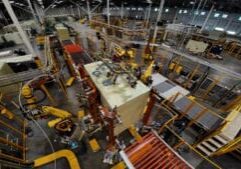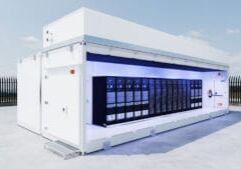The Bones of Modular Construction: Benefits and Challenges of 3 Common Building Materials
Wood, steel, and concrete: Each has been used in various forms of traditional construction for centuries (with steel being the most recent addition), and each provides specific benefits and challenges to consider. In a nutshell, wood is light and moderately strong, ideal for small and medium-sized buildings. Steel is heavier but stronger and perfect for taller, more complex frameworks. Concrete is the heaviest and is best suited for foundations and reinforced structures.
Each of these materials has its use in modular construction, as well. The modular construction process, however, allows for a slightly different set of benefits and challenges, and the design of the modular project can determine which materials need to be used during construction.
Below, we break open the nutshell and explore each material’s use in modular construction.


Modular Construction with Wood
According to Allison Arieff & Bryan Burkhart, the authors of the book “Prefab”, use of wood in modular construction is the most common practice since the seventeenth century. Using wood in modular construction is very beneficial due to its properties as a construction material. Wood is easy to manipulate by hand or with machinery, has low toxicity, is biodegradable, is easy to reuse and recycle, and is affordable. Wood is a combustible material that has an important thermal property in that it does not expand against heat. In fact, it gains strength when it dries out with more heat. Wood is also a good insulator against electricity (helps to minimize electrical shocks) and energy loss.
Common structural members used include 2X individual pieces used in roof trusses, floor trusses, walls; wood I-joists, engineered glue-laminated beams, plywood, oriented strand board (OSB) and composite panels. Wood is being used in the modular fabrication shop to create exterior wall panels that include additional layers for waterproofing, insulation, vapor barrier, drywall and siding.
Prefabrication in a factory allows the wood to stay dry and at a constant temperature while being precisely cut and fitted to exacting tolerances. Prefabrication minimizes waste, saves resources, and simplifies recycling of waste. Factory-produced components or modules can be transported to the site and assembled with extremely tight tolerances. With its ability to be manipulated, laminated and reused, wood will continue to be a sustainable material source for modular construction.
Modular Construction with Steel/Aluminum
Metals can be described as ductile, hard, conductive, precise, and strong. They are classified as ferrous and non-ferrous metals. Ferrous metals are primarily used in structural applications because they are strong, ductile and durable due to their high iron content. They can be treated with coatings such as galvanizing to prevent corrosion when exposed to weather and manipulated easily to create a variety of shapes and sizes. Non-ferrous are used in roofing and cladding applications and are natural corrosion-resistant metals.
Although steel is an expensive material when compared to wood and concrete, steel is the more economical choice if building long-span structures, high-rise structures and unique geometric designs because of its strength and speed of construction. Steel is inorganic and non-combustible material, therefore it has an advantage against fire. Another advantage of steel structures is that they are very strong and can survive even in the most critical weather conditions. It can be used for a long time due to its strength and durability. It can be transported easily and can be reused by unbolting its components.
Aluminum is a non-ferrous alloy that is ductile and well-known for its corrosion-resistance. It can be recycled repeatedly with little energy or loss of its material properties. Because aluminum is light and durable, it can be easily assembled into panels and modules, shipped and erected quickly and accurately.
Light-gauge steel components (which have a higher strength-to weight ratio) can be used in place of 2X lumber or in tandem with wood framing. For studs and rafters, members are formed into C-shaped sections. For top and bottom wall plates and joist headers, channel sections are used. Holes are placed in them every two feet to accommodate wiring and plumbing.
Modular Construction with Concrete
Traditional onsite construction involves concrete that is mixed from Portland cement, sand, aggregate (small gravel of various sizes) and water in a process called hydration which hardens (cures) the concrete to its specified strength (i.e., 3000 psi). Concrete relies on fiber and steel reinforcing for its tensile strength. The material is labor intensive because formwork must be erected, concrete placed (poured into the formwork), and then finished (troweled and smoothed).
Modular construction with concrete typically consists of buildings such as restrooms, concession buildings, shower facilities, shelters, utility buildings, etc. in which the walls are fabricated with high strength precast concrete or concrete masonry units (CMUs) and the roof can be constructed of lightweight precast concrete panels, metal panels, concrete tiles, or traditional architectural shingles. The buildings are designed and constructed to meet all local building codes. They can have a variety of color and texture options such as brick, stone, stucco, split-face block, board and bat siding, or horizontal lap siding. The buildings are prefabricated and delivered complete and ready-to-use, including plumbing and electrical where applicable. Modular concrete buildings can also be constructed on permanent, poured-in-place reinforced concrete foundations. These buildings are permanently anchored to a massive foundation with a deep footing designed for heavy seismic loads to ensure stability and integrity of the entire structure.
More from Modular Advantage
Resia: Breaking All the Rules
Resia Manufacturing, a division of U.S.-based Resia, is now offering prefabricated bathroom and kitchen components to industry partners. Its hybrid fabrication facility produces more precise bathroom and kitchen components (modules) faster and at lower cost than traditional construction. Here’s how Resia Manufacturing does it.
How LINQ Modular Innovates to Bring Modular To The Market in the UAE and Beyond
LINQ Modular, with an office and three manufacturing facilities in Dubai, is a modular firm based in United Arab Emirates. The company is on a mission: to break open the housing and construction markets in the Gulf Cooperation Council (GCC) area with modular.
ModMax: Redefining Modular Construction with Confidence and Precision
ModMax was born out of frustration—frustration with five persistent pain points in modular construction: Permitting bottlenecks. Production delays. Rigid designs. Disconnect between “the office” and the field. Lack of transparency and communication.
LifeArk: Disaster-Resilient Housing from Recycled Plastic and 100-year-old Technology
Wee compares LifeArk’s housing units to Yeti coolers, as they are built similarly. Each component takes 15 to 20 minutes to manufacture, has an R-value of 40, and includes molded slots and chases for wiring, plumbing, fire sprinklers, and other utilities.
Building the Future of Modular Edge Infrastructure
The edge data center market is expanding rapidly, driven by the surge in AI workloads, IoT adoption, and the need for localized compute power. In these environments, sustainability, scalability, and reliability are non-negotiable. Cooling is among the most complex challenges for operators—and one of the most decisive factors in long-term success.
Accelerating Light-Gauge Steel Construction: A Semi-Automated Digital Workflow for Off-Site Projects
For construction professionals, the message is clear. By adopting semi-automation and digitalization, companies can deliver projects faster, more accurately, and more profitably, while also building stronger collaboration across teams. The approach is not about replacing people with machines, but about empowering people with better tools and processes.
Why Modular Data Centers Are Gaining Momentum
Artificial intelligence, high-performance computing, and edge applications push the limits of traditional “stick-built” data centers. They take years build, often struggle with high density workloads, and aren’t optimized for deployments near end users. Modular data center platforms are purpose-built to address these challenges, offering flexibility and scalability to adapt to evolving technologies, while opening new opportunities for the modular construction industry.
Supply Chain Innovation in Action: 5 Habits Every Modular Leader Should Practice
By applying these principles to supply chain practices — collaborative planning, strategic procurement, scenario modeling, digital tools, and transparent forecasting — construction leaders can build value chains that are not just efficient and agile, but truly innovative.
Exploring the Role of Modular Integrated Construction (MiC) in Advancing Circular City Principles – A Survey of Stakeholder Perspectives
The survey findings highlight the significant potential of Modular integrated Construction (MiC) in advancing the development of circular cities. By reducing costs, accelerating construction timelines, and minimizing waste generation, MiC offers a promising approach to sustainable urban development.
The Use of MS POLYMER™-Based Sealants and Adhesives in Modular Building
These products combine flexibility and elastic recovery with excellent adhesion to different substrates and have already shown their usefulness in traditional construction. Now it’s time for them to be put to use in the modular construction industry.










